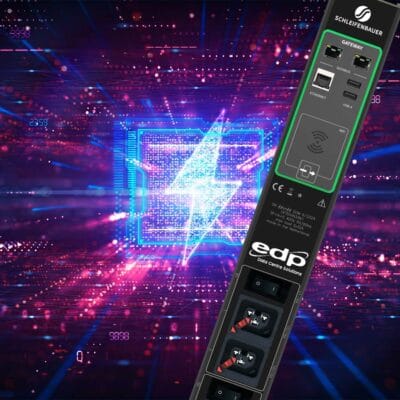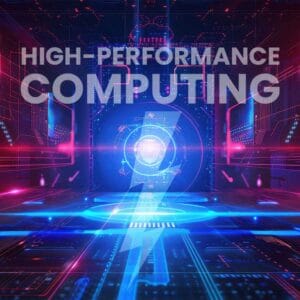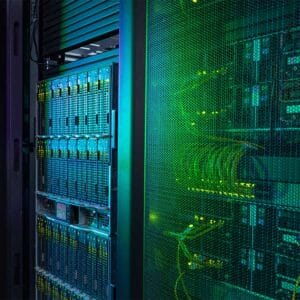HPC PDUs – Powering the Future of Computing
 HPC PDUs are the latest intelligent power distribution units.
HPC PDUs are the latest intelligent power distribution units.
As the realm of computing evolves at a breakneck pace, businesses are demanding High-Performance Computing (HPC) environments at unprecedented levels, which compels us to develop innovative solutions for effective power consumption management. High-Performance Computing, encompassing a range of applications from scientific research to complex data analysis, relies on robust Power Distribution Units (PDUs) to support its escalating energy needs.
In this comprehensive guide, we explore the world of HPC PDUs and their critical role in modern computing infrastructures. We will define HPC and its key applications, focusing on the growing power demands accompanying technological advancements. You will learn about the different types of PDUs: basic, metered, switched, and managed. You will also see why basic PDUs often do not work well in HPC settings. As smart PDUs become important for modern technology, we will show the main features of HPC-Ready Intelligent PDUs. These features greatly improve efficiency, reliability, and performance in high-performance computing settings. Join us as we navigate this vital topic, empowering you to make informed decisions for your HPC infrastructure.
In this article we will discuss:
High-Performance Computing (HPC) represents a specialised and advanced approach to computation, leveraging aggregated computing power to tackle complex calculations at unprecedented speeds. At its core, HPC involves the strategic utilisation of supercomputers and computer clusters. These clusters usually have thousands of processors. They often work together to handle complex tasks. HPC systems perform much better than regular desktop computers or even high-end servers. This is because they can process tasks in parallel.
Scientists, engineers, and researchers use HPC to address and solve problems that are too complex, data-intensive, or time-consuming for conventional computing resources. The ability to efficiently model complex systems and manage large datasets fuels discovery and innovation across various disciplines.
Key Applications of HPC: Driving Innovation Across Diverse Fields
High-performance computing (HPC) transforms various fields by fuelling breakthroughs and advancements through its widespread application:
- Scientific Research: Scientists harness HPC for indispensable simulations and modelling in critical domains. Climate scientists craft complex climate models using HPC to predict future scenarios and study factors influencing global weather patterns. Astrophysicists simulate celestial events like supernova explosions and galaxy formations with HPC, gaining insights into the universe’s evolution. Genomics researchers use HPC to analyse vast genomic datasets, accelerating gene discovery, understanding disease mechanisms, and developing personalised medicine approaches.
- Engineering: Engineers use HPC to design, optimise, and analyse complex systems. Aerospace engineers simulate airflow around aircraft via HPC, optimising wing designs and improving fuel efficiency. The automotive industry uses crash simulations and virtual prototyping. It also develops Advanced Driver-Assistance Systems (ADAS) with the help of HPC. Civil engineers employ HPC to model the structural integrity of bridges and buildings, assess natural disaster impacts, and optimise urban planning.
- Data Analytics: Data analysts rely on HPC to process, analyse, and interpret massive datasets. Financial institutions use HPC for risk management, fraud detection, and algorithmic trading. Marketing professionals analyse customer behaviour, personalise advertising, and optimise strategies using HPC. Healthcare providers analyse patient data with HPC to identify disease outbreak patterns and develop more effective treatment plans.
- Artificial Intelligence: AI, particularly machine learning and deep learning, advances through the support of HPC infrastructure. HPC trains complex AI models, enabling them to learn from vast data and generate accurate predictions. These AI models find applications in image recognition, natural language processing, and autonomous driving, where high-performance computing proves essential for progress.
The Growing Power Demands of HPC: Addressing the Energy Challenge
As HPC systems grow progressively more powerful and tackle increasingly complex problems, they dramatically increase their power consumption, often following an exponential growth trajectory. Modern HPC clusters consume megawatts of power, rivalling the energy consumption of small towns. This growing demand for power puts a lot of pressure on Data Centre infrastructure. It leads to major investments in cooling systems and power distribution networks.
Organisations must develop and implement advanced power distribution solutions to deliver power efficiently, reliably, and sustainably to HPC equipment. Managing power consumption is very important for the future of HPC. Strategies include designing energy-efficient hardware, using dynamic power management, and utilising renewable energy sources. Also, new cooling technologies like liquid cooling are important for managing the heat from high-density computing environments.
In any Data Centre or server room, a Power Distribution Unit (PDU) is very important. It distributes electrical power from one source to many devices. These devices include servers, networking equipment, and other IT equipment. By performing this task, PDUs ensure that each device receives the necessary power to function correctly.
Several types of PDUs exist, each designed to offer various levels of functionality and features to meet the diverse needs of Data Centres.
The four main PDU types include:
- Basic PDUs: Basic PDUs provide the most fundamental level of power distribution without any monitoring or control capabilities. They simply distribute power to the connected devices, making them ideal for straightforward setups or applications with minimal power management requirements.
- Metered PDUs: Offering an upgrade from basic PDUs, metered PDUs provide power consumption metrics in addition to basic power distribution. By monitoring the total power usage of the PDU, users can gain valuable insights into their power consumption patterns, optimise their energy usage, and identify potential issues before they become critical.
- Switched PDUs: Switched PDUs enhance power management by offering remote power control capabilities. Users can remotely switch on, switch off, or reboot individual outlets, providing greater flexibility and convenience in managing their IT equipment. With limited on-site Data Centre access or during power-related troubleshooting, this capability provides a significant advantage.
- Intelligent PDUs: As the most advanced PDU type, intelligent PDUs offer comprehensive power monitoring, remote control, and environmental monitoring capabilities. In addition to real-time power consumption data, they provide information on temperature, humidity, and other environmental factors, ensuring optimal operating conditions for IT equipment. These Managed PDUs have advanced features like load balancing. This helps share power evenly across many outlets. They also send alerts to warn users about possible power or environmental problems.
Choosing the right PDU type depends on the specific needs and requirements of the Data Centre or server room. By understanding the differences between basic, metered, switched, and intelligent PDUs, users can make informed decisions and invest in a PDU solution that best suits their power management and monitoring objectives.
High Performance Computing (HPC) environments demand powerful and advanced infrastructure to support their complex and resource-intensive workloads. Power Distribution Units (PDUs) play a critical role in this infrastructure by providing power to various devices and equipment in the Data Centre.
The limitations of basic PDUs restrict their usability in HPC environments:
- Firstly, basic PDUs lack advanced monitoring and control capabilities, challenging effective management of power consumption. Data Centre managers cannot track the power usage each device uses or identify potential issues before they become critical. Without this information, managers struggle to optimise power usage, leading to inefficiencies and increased costs.
- Secondly, HPC environments are known for their high-power density, a consequence of concentrating substantial power in a minimal space. Basic PDUs are often inadequate for high power densities, which can result in overheating, downtime, and other problems. In HPC settings, downtime translates to significant costs through lost productivity and revenue.
- Thirdly, basic PDUs do not provide the granularity HPC environments need. In these situations, it is important to monitor and control power usage closely. Even small inefficiencies can add up to significant costs over time. Basic PDUs lack this level of detail, complicating efforts to optimise power usage and detect potential issues.
Designed specifically for HPC environments, intelligent HPC PDUs offer features not found in basic power distribution units. They provide advanced monitoring and control capabilities, equipping Data Centre managers with real-time information about power usage, temperature, and other critical factors. Managers use this information to optimise power usage, pre-emptively address potential issues, and prevent downtime. Intelligent PDUs also offer detailed granularity, enabling precise monitoring and control of power usage. This granularity is vital in HPC environments where even small inefficiencies can result in significant costs over time.
While basic PDUs might suffice for simple IT environments, they fall short in meeting HPC’s rigorous demands. Their limitations in monitoring, managing high power density, and granularity make power consumption management, issue identification, and optimisation challenging. In HPC settings, where power density is high and downtime is expensive, intelligent PDUs are crucial. They help ensure good performance, efficiency, and reliability.
 In an era defined by ever-increasing computational demands, intelligent HPC PDUs are indispensable components of modern technological infrastructure. Today’s advanced power distribution units transcend basic capabilities, offering features crucial for maintaining Data Centres’ reliability, efficiency, and sustainability. By transforming power management from mere distribution to sophisticated monitoring, control, and optimisation, they mark a change in basic assumptions.
In an era defined by ever-increasing computational demands, intelligent HPC PDUs are indispensable components of modern technological infrastructure. Today’s advanced power distribution units transcend basic capabilities, offering features crucial for maintaining Data Centres’ reliability, efficiency, and sustainability. By transforming power management from mere distribution to sophisticated monitoring, control, and optimisation, they mark a change in basic assumptions.
Why Intelligent HPC PDUs are Vital:
- Enhanced Power Monitoring: Intelligent PDUs deliver real-time data on power consumption at the outlet level, enabling Data Centre managers to precisely monitor energy usage. This granular visibility helps organisations identify inefficiencies, optimise power allocation, and reduce energy waste. By analysing power draw per-device or per-outlet, managers can pinpoint “power hogs,” uncover underutilised resources, and proactively prevent overloads. This data supports informed decisions on equipment placement, upgrades, and energy strategies, and helps create accurate billing and chargeback models.
- Remote Management: Intelligent PDUs offer remote control capabilities, allowing administrators to power on/off, reboot, or cycle power remotely. This feature is crucial in geographically distributed environments or when managing unresponsive equipment. By eliminating the need for physical intervention, organisations save costs on travel and labour. Remote power cycling can resolve IT issues swiftly, minimising downtime and enhancing system availability. Security features such as user authentication and access control ensure only authorised personnel manage power distribution.
- Environmental Monitoring: Environmental sensors in most intelligent PDUs track temperature, humidity, and other factors. This information keeps IT equipment in optimal conditions, preventing failures from overheating or excessive humidity. Pre-emptive environmental monitoring allows administrators to address potential issues before they become critical by adjusting cooling systems and airflow patterns. Intelligent PDUs can integrate with Building Management Systems (BMS) to provide a holistic view of the Data Centre environment.
- Alerting and Notifications: Intelligent PDUs monitor for crucial thresholds and send alerts in cases where the power consumption is high, or temperature spikes occur. These alerts facilitate quick administrator responses, minimising downtime and avoiding equipment damage. Configuring alerts to specific thresholds and preferences ensures timely and relevant information delivery. This forward-thinking maintenance approach prevents minor issues from escalating, with integration providing a unified IT infrastructure view.
- Data Logging and Reporting: Intelligent PDUs log historical power consumption data, providing insights for capacity planning, trend analysis, and energy management. These logs are instrumental in generating reports for tracking energy use, identifying improvement areas, and demonstrating compliance with efficiency standards. By analysing this data, organisations can project power needs, optimise resources, and identify energy conservation opportunities. Sharing reports with stakeholders highlights effective energy management and compliance with regulations.
Intelligent PDUs are sophisticated devices that drive organisations to optimise power usage, enhance reliability, and reduce costs. They manage the complexities of modern Data Centres. They do this with features like clear visibility, remote control, environmental monitoring, and proactive alerts. This ensures continuity and supports a sustainable future.
Engineers meticulously design an HPC-Ready Intelligent PDU (Power Distribution Unit) to address the distinct and demanding power needs of High-Performance Computing (HPC) environments. Unlike standard PDUs, these special units provide advanced features. These features are important for reliable power distribution.
They also help with efficient power management. This ensures the best performance for sensitive and power-hungry HPC equipment. They play a crucial role in maintaining uptime and optimising the operational efficiency of HPC clusters.
Key Capabilities in Detail:
High Power Density Support: In HPC environments, exceptionally high-power densities characterise the scene as individual racks draw significant amounts of electricity. HPC-Ready Intelligent PDUs withstand and manage these extreme loads. They deliver substantial power to individual racks, often supporting high-amperage connections and robust power distribution architectures. This ensures that each server and HPC component receives the necessary power without overloading the system. They often support various high voltage and amperage configurations (e.g., 208V, 400V, 60A, 100A) to match the specific requirements of HPC hardware.
- Advanced Power Monitoring: To gain insight into power usage, which is crucial for efficient resource allocation and cost management, HPC-Ready Intelligent PDUs provide real-time power monitoring at the individual outlet level. This granular monitoring encompasses a wide range of metrics, including voltage, current, power factor, and aggregate energy consumption (kWh). With this detailed data, administrators can manage power more easily. They can find inefficiencies and improve power use in the HPC cluster. They can also track energy costs for billing and chargeback. This level of detail also allows for predictive maintenance and identifies failing components before they cause downtime.
- Remote Power Control: Remote management and control of power distribution serve as critical assets in HPC environments, particularly for geographically dispersed or unmanned facilities. HPC-Ready Intelligent PDUs facilitate remote power on/off, reboot, and power cycling of individual outlets. This remote-control capability enables administrators to manage HPC equipment from any location, diagnose and resolve issues rapidly, and respond swiftly to unexpected events. It allows them to remotely power cycle hung servers, enforce power capping policies, and schedule power outages for maintenance, all without requiring physical access to the Data Centre.
- Environmental Monitoring: To maintain optimal environmental conditions essential for the reliable operation of HPC equipment, avoid overheating and excessive humidity, which can lead to performance degradation, component failure, and costly downtime, HPC-Ready Intelligent PDUs incorporate environmental sensors. These sensors continuously monitor critical parameters such as temperature, humidity, airflow, and even potentially liquid detection. This real-time environmental data helps administrators proactively maintain optimal operating conditions, identify potential hot spots, and prevent equipment damage. By using the data, it enables the optimisation of cooling systems, airflow improvements, and potentially damaging leaks or spills avoided.
- Alerting and Notifications: For initiative-taking problem detection and rapid response, key to minimising downtime in HPC environments, HPC-Ready Intelligent PDUs can be set up to send automated alerts and notifications when critical thresholds are exceeded. Various events can trigger these alerts, including high-power consumption, temperature spikes, humidity fluctuations, network connectivity issues, or detected power anomalies.
These alerts help administrators quickly fix potential problems. They can find root causes and apply solutions before small issues turn into significant ones. This reduces downtime, prevents equipment damage, and keeps the HPC cluster stable. Delivery channels for alerts include email, SMS, and SNMP traps. - DCIM Integration: HPC-Ready Intelligent PDUs facilitate seamless integration with Data Centre Infrastructure Management (DCIM) software, a key component of comprehensive HPC environment management. Their design ensures easy integration with leading DCIM platforms, enabling centralised power and environmental data monitoring, management, and reporting. This integration makes it easier to monitor performance. It allows for trend analysis and gives a complete view of the Data Centre infrastructure. It also helps with better capacity planning. It also enables automated workflows for power management, environmental control, and incident response, further streamlining operations and improving overall efficiency. By integrating with DCIM tools, administrators can access historical data for analysis and predictive maintenance, correlating power consumption with application performance to optimise resource allocation.
An HPC-Ready Intelligent PDU serves as more than just a power strip—it acts as a critical infrastructure component, driving the dependable, efficient, and manageable operation of High-Performance Computing environments. These PDUs provide advanced power monitoring, remote control, environmental sensing, alerting features, and DCIM integration. This helps administrators optimise power use, avoid downtime, and support their HPC projects.
Organisations that rely on HPC for research, development, or important business tasks should invest in these devices. This will help them achieve their goals. Additionally, they assist in achieving Green and Sustainability objectives.
Using intelligent Power Distribution Units (PDUs) within High-Performance Computing (HPC) environments yields significant advantages for Data Centre efficiency, boosting performance, improving reliability, and reducing costs.
These benefits include:
- Improved Power Usage Effectiveness (PUE): Intelligent HPC PDUs deliver granular, real-time power monitoring at the outlet level, allowing administrators to precisely identify energy inefficiencies. This detailed insight enables them to optimise power consumption by identifying and eliminating phantom loads, right-sizing power supplies, and implementing dynamic power capping. By reducing energy waste and optimising power delivery, intelligent PDUs notably improve PUE, fostering a more sustainable and cost-effective operation.
- Increased Uptime: Intelligent PDUs offer remote monitoring and control capabilities that traditional power management lacks, allowing administrators to respond quickly and effectively to potential issues. They use threshold-based alerts to notify administrators of potential overloads, power imbalances, or environmental anomalies. Moreover, remote rebooting capabilities ensure quick resolution of frozen servers or unresponsive equipment without a physical presence in the Data Centre. This visionary approach minimises downtime, guaranteeing the continuous operation of critical HPC applications.
- Reduced Operating Costs: Intelligent PDUs facilitate optimised power usage, translating directly to lower operating costs. By reducing energy waste through precise monitoring and management, organisations significantly decrease energy bills. Increased uptime helps reduce revenue loss from service disruptions. Actively finding and fixing potential issues lowers maintenance costs. This prevents expensive repairs or replacements.
- Enhanced Capacity Planning: Intelligent PDUs provide historical data on power consumption at a granular level, crucial for effective capacity planning in HPC environments. Administrators can accurately forecast future power needs, make informed decisions regarding resource allocation, server placement, and infrastructure upgrades. Understanding peak demands and identifying underutilised resources allows administrators to optimise capacity utilisation, avoiding unnecessary investments and ensuring efficient resource allocation.
- Better Environmental Management: Intelligent PDUs equipped with environmental sensors monitor temperature, humidity, and airflow within the Data Centre, maintaining optimal environmental conditions crucial for reliable operation of sensitive HPC equipment. Administrators receive real-time alerts when conditions deviate from optimal ranges, allowing them to proactively adjust cooling systems or airflow management strategies. By proactively managing overheating and humidity, this approach ensures greater reliability and a longer lifespan for HPC infrastructure.
Conclusion
 In conclusion, we must understand the critical role of High-Performance Computing (HPC) Power Distribution Units (PDUs) as we navigate the ever-evolving landscape of modern computing. As we have explored, not only do HPC applications drive significant advancements in fields such as Artificial Intelligence, data analysis, and scientific simulations, but they also require a robust and capable power infrastructure to support their energy-intensive operations. Basic PDUs can be a simple solution, but they do not meet the complex needs of HPC environments, highlighting the need for smart HPC PDUs. With advanced capabilities such as real-time monitoring and enhanced energy efficiency, HPC-Ready Intelligent PDUs become indispensable assets in optimising performance and reliability.
In conclusion, we must understand the critical role of High-Performance Computing (HPC) Power Distribution Units (PDUs) as we navigate the ever-evolving landscape of modern computing. As we have explored, not only do HPC applications drive significant advancements in fields such as Artificial Intelligence, data analysis, and scientific simulations, but they also require a robust and capable power infrastructure to support their energy-intensive operations. Basic PDUs can be a simple solution, but they do not meet the complex needs of HPC environments, highlighting the need for smart HPC PDUs. With advanced capabilities such as real-time monitoring and enhanced energy efficiency, HPC-Ready Intelligent PDUs become indispensable assets in optimising performance and reliability.
By investing in these technologies, organisations can not only meet the growing power demands of HPC but also pave the way for innovation and success in their computational endeavours. As we continue to push the boundaries of what is possible in computing, choosing HPC-ready Intelligent PDUs becomes not only a wise decision but a vital step toward thriving in an increasingly power-hungry digital world. Embrace this technology to empower your HPC environment and drive your organisation’s success.



